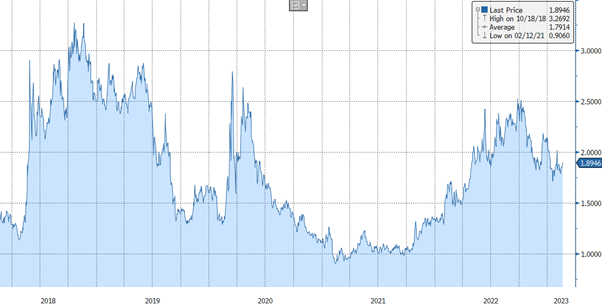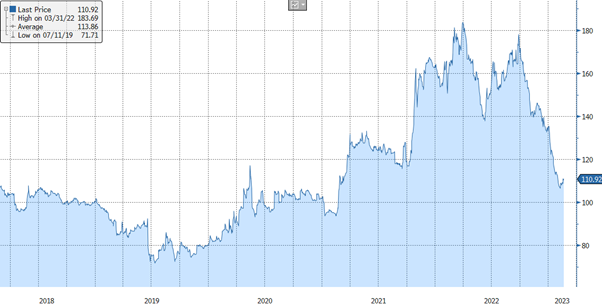
It’s grim, but not as bad as we were told it would be…
15 February 2023
Hawks Gather in February
24 February 2023RISK INSIGHT • 21 FEBRUARY 2023
Beware the Sleeping Giant

Shane O'Neill, Head of Interest Rate Trading
In the years following the financial crisis, interest rate markets globally were defined by low volatility and low rates—none more so than the market in Europe. From 2009 onward, the ECB depo rate spent most of its time in negative territory. Apart from two (ill-advised) hikes in 2011, the rate saw one-way traffic with 13 cuts in total, leaving it at -0.5%. This period created an attitude of nonchalance amongst hedgers and investors: financing terms virtually always included floors and, with no prospect of rates moving higher, protection was deemed unnecessary. While the recent inflation crisis has changed things globally, hedging complacency remains entrenched in European markets. With markets continuing to evolve in Europe, we turn our attention to the most recent developments and the implications for macro risk managers.
Rates Continue Higher
Over the last two years, markets have been consistently behind the curve in pricing rates higher. Hawkish moves from central banks have increased rates steadily, with the most recent of these moves occurring in Europe.
In an interview last week, ECB executive board member Isabel Schnabel stated that markets are too optimistic in their pricing of rates and highlighted that there is a risk that inflation will remain sticky. The data is helping her point. Although we have finally seen a tick lower in headline numbers, core inflation continues to move higher. This has been exacerbated by historically tight labour markets: in its most recent forecasts, the ECB increased wage growth expectations and now expects it to run at a minimum of double its inflation target through 2025. To quote Schnabel, this means that another 50bps hike in March is “necessary under virtually all plausible scenarios.”
While late to the party, the ECB has now made it clear that rates need to go higher, quickly—with the markets slowly taking heed. Terminal rates at the start of the month were expected to come in at 3.25% and are now looking to come in closer to 3.75%. This is still ~0.75% lower than expectations in the UK, a comparison with some merit as both regions have core inflation running at over 5% with no signs of abating. The caveat in the EU has always been the same: it is difficult to ensure the even transmission of higher rates across the bloc. But are we seeing signs of progress on this front?
Peripheral Spreads Play Ball
We have pointed toward peripheral spreads—the difference between the borrowing costs of peripheral bloc nations and Germany—many times as an indicator of the overall health of the bloc.
After the ECB began hiking rates last year, we saw the spread between Germany and Italy climb some 60bps, prompting the bank to call an emergency meeting. The correlation was clear: higher rates led to wider spreads which would, at some point, become a limiting factor in the fight against inflation. The Italians—heavily indebted and no great fans of the bureaucrats in Brussels—made their feelings clear, calling the hikes “unbelievable” and “baffling”. But in recent weeks, this correlation has broken: as rate expectations in the EU climbed, peripheral spreads fell. For example, Italian/German spreads are now at their 5y average while Greece/Portugal spreads are below the 5y average. Should this environment persist, it will take one risk off the table for the ECB and enable the bank to hike more freely, as it clearly wants to do.
Chart 1: German/Italian bond spreads have been falling lately, potentially freeing up the ECB to continue hiking.

Source: Bloomberg
Hedging Opportunities
Climbing rates suggest that hedging is becoming more expensive and, indeed, 5y swap rates are nearing the highest levels seen since 2008. The options market, however, presents an opportunity. Easing peripheral spreads have led to a fall in implied volatilities, meaning the cost to purchase a 5y cap struck at 4% is less than half the price it was in October last year. With Euro rates potentially heading toward the levels seen in the UK—and perhaps beyond—this recent pullback presents those still unhedged with a great chance to take their Euro rates risk off the table.
Chart 2: Falling implied volatilities have counteracted the move higher in rates, making caps a cheaper option for hedgers.

Source: Bloomberg
Be the first to know
Subscribe to our newsletter to receive exclusive Validus Insights and industry updates.

